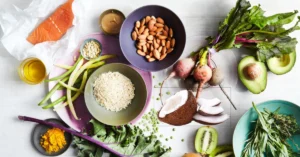If you’re craving a culinary adventure that transports you straight to a tropical paradise, exploring exotic tropical fruits is the way to go. These vibrant, flavorful fruits not only add a burst of color to your plate but also offer unique tastes and health benefits that are sure to captivate your palate. This guide will introduce you to some must-try tropical fruits, and we’ll even touch on the lesser-known tropical vegetables and root vegetables that complement them beautifully.
Discover the Wonders of Tropical Fruits
What Makes Tropical Fruits So Special?
Tropical fruits are grown in warm, humid climates, often found near the equator. They are renowned for their diverse flavors, textures, and nutritional benefits. Here’s why you should consider incorporating them into your diet:
• Rich Flavors: From sweet to tangy, tropical fruits offer an array of flavors that can transform any meal.
• High Nutritional Value: Packed with vitamins, minerals, and antioxidants, these fruits contribute to a healthy diet.
• Exotic Appeal: Their unique tastes and vibrant colors add a touch of the exotic to your everyday dishes.
Must-Try Tropical Fruits for Your Taste Buds
1. Mangosteen
Often called the “queen of fruits,” mangosteen has a sweet, tangy flavor reminiscent of peach and pineapple. The fruit’s white, juicy flesh is encased in a thick, purple rind. Mangosteen is known for its antioxidant properties and can be enjoyed fresh or in smoothies.
2. Rambutan
This hairy fruit is a cousin of the lychee and has a similar sweet flavor with a hint of tartness. Rambutan’s translucent flesh is juicy and refreshing, making it a popular choice for fruit salads and desserts.
3. Dragon Fruit
With its striking pink skin and speckled flesh, dragon fruit (or pitaya) is as visually stunning as it is tasty. The fruit has a mildly sweet flavor and a texture similar to kiwi. It’s rich in vitamin C and antioxidants, making it a nutritious addition to your diet.
4. Passion Fruit
Passion fruit, with its wrinkled purple or yellow skin, contains a jelly-like pulp filled with seeds. The pulp has a tangy, tropical flavor that pairs well with both sweet and savory dishes. It’s excellent in juices, desserts, and salad dressings.
5. Starfruit
Also known as carambola, starfruit gets its name from the star-shaped slices it forms. Its flavor ranges from sweet to tart, and it’s rich in vitamin C and fiber. Starfruit can be eaten fresh, juiced, or added to salads.
Exploring Tropical Vegetables and Root Vegetables
While tropical fruits steal the spotlight, tropical vegetables and root vegetables also play a crucial role in these vibrant cuisines. Here’s a glimpse into these often-overlooked ingredients:
Tropical Vegetables: A Savory Twist
1. Cassava
Cassava, also known as yuca, is a starchy root vegetable that serves as a staple in many tropical diets. It’s used to make tapioca and can be boiled, fried, or baked. Cassava has a nutty flavor and is high in carbohydrates.
2. Taro
Taro is a versatile root vegetable with a slightly nutty flavor. Its purple-tinged flesh is used in various dishes, from savory stews to sweet desserts. Taro is rich in dietary fiber and vitamins.
Root Vegetables: Adding Depth to Tropical Dishes
1. Sweet Potatoes
Sweet potatoes are a tropical root vegetable that adds natural sweetness to dishes. They’re packed with vitamins A and C, making them a nutritious addition to any meal. Try them roasted, mashed, or in soups.
2. Jicama
Jicama, or Mexican turnip, is a crunchy, slightly sweet root vegetable often used in salads and slaws. It’s low in calories and high in fiber, making it a great choice for healthy snacking.
Tips for Incorporating Tropical Fruits and Vegetables
1. Mix and Match
Combine tropical fruits with other fruits and vegetables to create vibrant salads or smoothies. For instance, mix mangoes with avocados and lime for a refreshing salad.
2. Experiment with Cooking
While many tropical fruits are delicious raw, try cooking them to explore new flavors. Grilled pineapple or roasted sweet potatoes can add depth to your meals.
3. Preserve Freshness
If you can’t consume tropical fruits immediately, freeze them for later use. Most tropical fruits freeze well and can be used in smoothies, desserts, or cooking.
4. Use in Traditional Dishes
Incorporate tropical vegetables into traditional dishes from their regions of origin. For example, use cassava in Brazilian stews or taro in Asian desserts.
Conclusion
Incorporating exotic tropical fruits, vegetables, and root vegetables into your diet is more than just a culinary adventure; it’s an opportunity to explore a range of flavors and textures that can enhance your meals. Whether you’re sampling the sweet tang of a mangosteen, the unique texture of rambutan, or experimenting with tropical root vegetables like cassava and taro, these ingredients offer a refreshing twist to your usual fare.
Embrace the vibrant flavors and health benefits of tropical produce to elevate your cooking and enjoy a taste of paradise from the comfort of your home. So, why wait? Head to your local market, find these exotic delights, and let your taste buds experience a tropical getaway today! peppers vegetable








+ There are no comments
Add yours